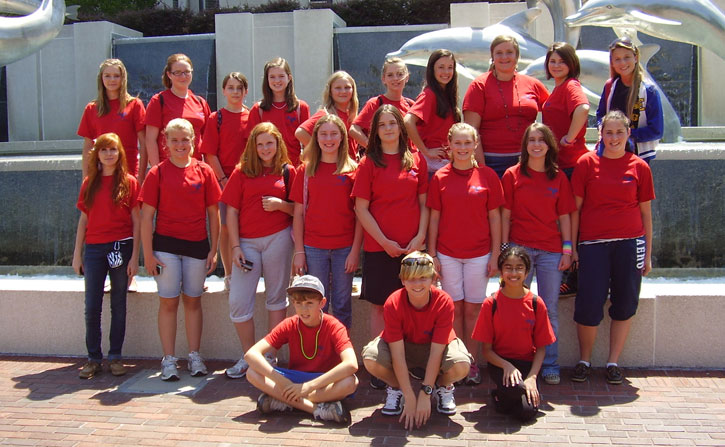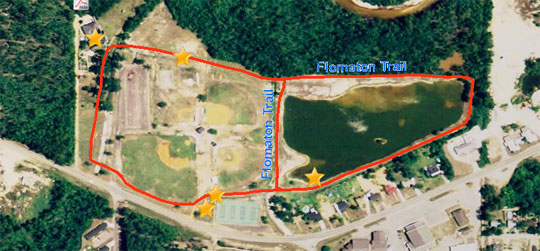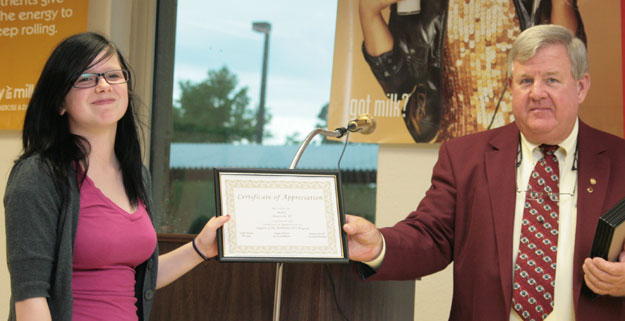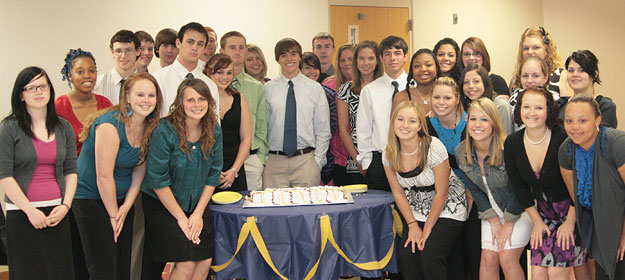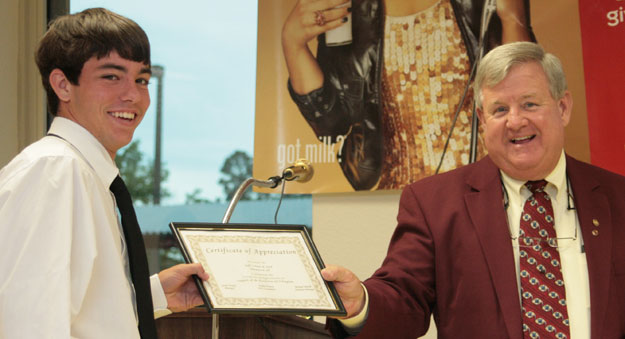Parents, Students Learn About New Ernest Ward Electrical Academy
May 26, 2010
A new program at Ernest Ward Middle School will provide students the opportunity to learn all about electricity and green power.
Tuesday, parents and students had the opportunity to learn more about the IBEW Electrical Academy at Ernest Ward Middle School. The academy, which begins in August, is the first such program in the nation at the middle school level.
The International Brotherhood of Electrical Workers will work with the school district to create the Electrical Academy. Middle school career academies are small, personalized learning communities within a school in which select students and teachers participate during a two or three-year span. A career academy involves teachers from different subjects working together as an interdisciplinary team.
“We are really going to emphasize going green,” Reagan McDaniel, business manager for the IBEW Local Union 676, said while standing in front of trailer-mounted solar panels capable of generating about 2,000 watts of power. “It’s important that students learn about green power options.”
In the EWMS Electrical Academy, the students will be introduced to electrical systems, learn the theories of electricity and gain valuable hands-on experience with various projects. Part of that hands-on experience will include learning how to wire a home. While students will work with AC (household type) electrical systems, most projects will use DC (battery type) voltage for safety reasons.
During a recent registration period, 167 incoming seventh and eight grade students signed up for the Electrical Academy, according to Principal Nancy Gindl-Perry. The academy, she said, will only be able to accept about 40 students from each grade level. School grades, FCAT scores and behavior records will play a factor in which students are selected for the program.
For seventh and eight grade students, the academy will be two semesters. Sixth grade students will have the opportunity to take Electrical Academy classes as part of the “wheel” — a nine week course.
“My son is an electrical engineer,” said Gayle Hanks, Ernest Ward guidance counselor. “He said that students that gain the hands on training before college will hold an advantage.”
McDaniel said that current plans call for expanding the IBEW electrical academy to Northview High School.
During the school day, current sixth and seventh grade students were given the chance to see the trailer mounted solar panels in action — powering a fan, leaf blower and vacuum cleaner.
Pictured top: Local IBEW Business Manager Reagan McDaniel explains solar panels capable of generating 2,000 watts of electricity Tuesday afternoon at Ernest Ward Middle School. NorthEscambia.com photo, click to enlarge.
Ernest Ward SGA Visits Tallahassee (With Gallery)
May 24, 2010
The Ernest Ward Middle School Student Government Association visited several landmarks in Tallahassee over the weekend, including the state capitol, governor’s mansion, the Florida State University campus and several museums.
For a submitted photo gallery, click here.
Pictured above at the state capitol are (front, L-R) Jason Ogle, Austin Cunningham, Shalmali Bhadkamkar, (middle) Danielle Scott, Tamara Wise, Megan Bryan, Samantha Sharpless, Kendal Cobb, Madlyn Coon, Kasie Braun, Lana Clayton, (back) Chelsea Turner, Amy Murph, Bethany Reynolds, Jordan Taylor, Katie Born, Jayln Bodiford, Jessica Lowery, Jenny Spears, Victoria Wright, and Chelsea Ward. Pictured below: Amy Murph plays the piano at the Florida Governor’s Mansion. Submitted photos for NorthEscambia.com, click to enlarge.
Charles Lymon Graduates From Basic Training
May 23, 2010
 Air Force Airman Charles E. Lymon Jr. graduated from basic military training at Lackland Air Force Base, San Antonio, Texas.
Air Force Airman Charles E. Lymon Jr. graduated from basic military training at Lackland Air Force Base, San Antonio, Texas.
The airman completed an intensive, eight-week program that included training in military discipline and studies, Air Force core values, physical fitness, and basic warfare principles and skills.
Airmen who complete basic training earn four credits toward an associate in applied science degree through the Community College of the Air Force.
He is the son of Jeannette Lymon of Old Jack Springs Road, Atmore. Lymon graduated in 2004 from Escambia County High School, Atmore, and received a bachelor’s degree in 2008 from Auburn University.
Jordan, Wilson To Wed
May 23, 2010
 Mr. and Mrs. Lloyd Jordan are pleased to announce the engagement of their daughter, Lindsey Gayle, to Mr. Jeremiah Jack Wilson, the son of Mr. and Mrs. Willie Wilson.
Mr. and Mrs. Lloyd Jordan are pleased to announce the engagement of their daughter, Lindsey Gayle, to Mr. Jeremiah Jack Wilson, the son of Mr. and Mrs. Willie Wilson.
Miss Lindsey is the granddaughter of Jimmy and Barbara Wilson of Byrneville and the late Gary and Nell Jordan of Flomaton. The prospective groom is the grandson of the late Mr. and Mrs. Harvey Odom of Century and the late Mr. and Mrs. Alton Wilson of Century.
The wedding will be held at 3 p.m. on Saturday, May 29, at the Beulah Chapel Assembly of God in Byrneville. A reception will follow.
All friends and family are invited.
Habitat Home Is Dream Come True
May 23, 2010
An army of volunteers descended on Nokomis Saturday morning as the 17th Escambia County Habitat for Humanity home began to take shape.
 Construction workers, teachers, bankers, business owners, high school students, ordinary people — about 85 people from all walks of life were all there volunteering their time and skills to make Jennifer Dorriety’s dream of home ownership a reality.
Construction workers, teachers, bankers, business owners, high school students, ordinary people — about 85 people from all walks of life were all there volunteering their time and skills to make Jennifer Dorriety’s dream of home ownership a reality.
Construction on the home started Friday. By the “lunch break” call Saturday, walls were up, the floor and roof trusses were nearly complete.
“It was amazing, just breathtaking this morning to see it; I never expected to see this much done in one day,” Dorriety said as she helped to work on the home that will be ready for her and her 13-year old daughter Kaylee to occupy in about a month. “I just really appreciate the volunteers that are out here working so hard. It’s a dream come true.”
Many of the volunteers, like Brittany Thompson, 16, had never had in part in building a house.
“I’m here because I wanted to help the people,” said Thompson, one of 14 students from Northview High School that spent part of their Saturday working on the two bedroom home. “They never had a home of their own, and the home they are living in now is falling apart.”
For a photo gallery from Saturday’s Habitat for Humanity build, click here.
“We have been pleased with the volunteer turnout and the financial support from different companies and groups”, said Escambia County Habitat for Humanity Executive Director Alecia Glaize. A long list of sponsors provided at least $500 in “groundbreaking” support and committed to at least 100 volunteer hours.
Houses constructed by the non-profit Habitat group are not free for recipients like Dorriety. The homes are sold to families at cost — there’s no profit for Habitat. The 20 year mortgages are at zero percent interest, providing much needed savings for those are unable to afford a conventional mortgage. And new homeowners are required to invest 400 “sweat equity” hours working for Habitat.
Dorriety’s new home will continue to save her money for years to come, Glaize said. It incorporates many “green” and sustainable features, like Hardiplank siding, a composite concrete and wood fiber board; bamboo flooring and a long list of energy efficiency features.
The Nokomis Habitat build was a change for the group that has constructed 16 homes in Brewton. It’s the first outside of Brewton, the first in a rural area, the first on a raised foundation, and the first on the future homeowner’s land. But it won’t be the last; plans are underway for an additional home near Atmore.
Volunteers are still needed to help build the home at 118 Johnson Road in Nokomis. Additional work days are scheduled for Sunday, May 23; Friday, May 28; Saturday, May 29; Saturday, June 5 and Saturday, June 12.
“It’s fun to help and advance the Kingdom of God,” said volunteer Shinora Redmond from Alto Products, one of Habitat’s sponsors for the Nokomis home.
For more information about Escambia County Habitat for Humanity, or to learn how to help build Dorriety’s home, visit www.escambiahfh.org.
For a NorthEscambia.com photo gallery from Saturday’s Habitat for Humanity build, click here.
Pictured top: Volunteers work to construct a house for Escambia County Habitat for Humanity Saturday morning Nokomis. Pictured inset: Future resident Jennifer Dorriety. Picture below: Northview High School construction technology teacher Tom Meehan lends a helping hand. NorthEscambia.com photos, click to enlarge.
Tate Multimedia Students Appear On TV , Collect $1,000
May 21, 2010
Three students from Tate High School’s Multimedia Academy appeared on WEAR TV’s “Dayside” show Friday morning. The students were recognized for producing the winning video for the annual WEAR Lewis Bear “Don’t Drink and Drive” video contest.
Senior Denise Rivers, sophomore Breanna Harrison and freshman Amy Sapp appeared on the program to accept a $1,000 check from Lewis Bear for the Multimedia Academy at Tate.
The “Live Responsibly” video produced by the three Tate students placed first in the competition. The winning video aired on Channel 3 during prom season.
Pictured above: Tate High Multimedia Academy students Breanna Harrison, Denise Rivers and Amy Sapp. Submitted photo for NorthEscambia.com, click to enlarge.
Tribal Beat’s Moretz Receives Band Camp Scholarship
May 21, 2010
 The Northview High School Tribal Beat’s Melissa Moretz is among six area high school students to receive summer band camp scholarships from the Pensacola Civic Band.
The Northview High School Tribal Beat’s Melissa Moretz is among six area high school students to receive summer band camp scholarships from the Pensacola Civic Band.
The scholarships were funded by the Pensacola Civic Band’s yearly holiday concerts at band sponsor Pensacola Junior College. The Civic Band has distributed more than $40,000 through the years for these scholarships.
Moretz will receive a partial scholarship to the Florida State University Marching Band Leadership Camp in July.
This year’s scholarship recipients from the Pensacola Civic Band are:
- Melissa Moretz, Northview High School
- Mahagony Lee, West Florida Tech
- Garrett McCrary, Washington High School
- Brandon Spencer, Washington High School
- Megan Roberts, Ft. Walton Beach High School
- Bobby Wagner, Ft. Walton Beach High School
NorthEscambia.com file photo, click to enlarge.
Escambia County Honors Tate Mock Trial Team
May 20, 2010
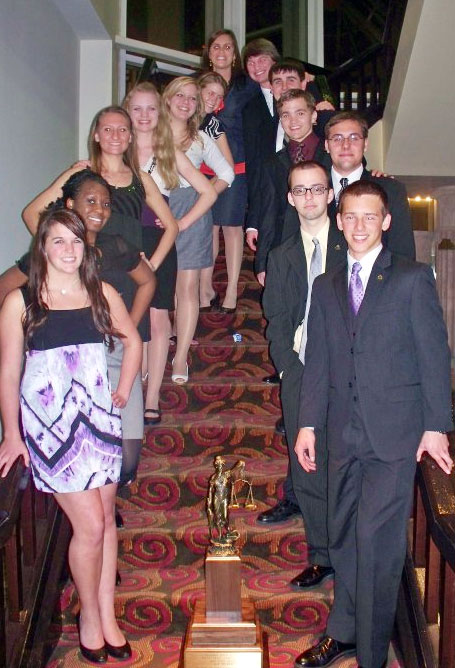 Tate High School’s Mock Trial Team was honored Thursday night by the Escambia County Commission for winning state in the Florida High School Mock Trial Competition tournament and placing in the National High School Mock Trial Championship.
Tate High School’s Mock Trial Team was honored Thursday night by the Escambia County Commission for winning state in the Florida High School Mock Trial Competition tournament and placing in the National High School Mock Trial Championship.
Members of the team are Collin Metcalf, Dylan Lunsford, Allison Baliey, Jacob Sander, Asia Cravens, Amy Sapp, Denis McKinnon III, Josh Levins, Austin Perry, Sarah Barlow,Ashley Fasshauer, and Brooke St. Pierre. Collin Metcalf also won the “Best Attorney” award at the state competition.
At the National High School Mock Trial Championship earlier this month in Philadelphia, the Tate team placed 27th. In addition, Collin Metcalf was presented the Judge Marjorie O. Rendell Outstanding Performance Award at the national level.
The group is coached by Amanda Brown. Former coach Kelly Krostag and Attorney Aaron Watson from The Levin Firm also worked with the group.
Pictured: (left of stairs, bottom to top) Brooke St. Pierre, Asia Cravens, Ashley Fasshauer, Amy Sapp, Sarah Barlow, Allison Bailey, coach Amanda Brown, (bottom of stairs, bottom to top) Dylan Lunsford, Austin Perry, Jacob Sander, Josh Levins, Collin Metcalf, Denis McKinnon III. Submitted photo for NorthEscambia.com, click to enlarge.
Walking Trail Featured In State Guide
May 20, 2010
Looking for a good place to walk? A trip around Flomaton’s Hurricane Park is one of the best walks in Alabama.
The “Alabama’s Passport to Fitness” walking trail guide from the Alabama Department of Economic and Community Affairs lists the walk around the park as one of the 85 best Passport Trails in the state.
Welcome centers across Alabama, as well as each community with a trail, will provide the official Passport Guide that contains maps of the trails and points of interest. In addition, the “Passport Stamp Page” allows walkers to collect an official passport stamp for each trail walked.
An online GIS interactive web page provides a virtual map that contains street maps and aerial imagery for each trail.
 Flomaton’s Hurricane Park is an easy walk around a playground on a paved track. The walk passes the Turtle Point Environmental Science Center (pictured), a hands-on experience located on twenty acres of wetlands on Big Escambia Creek. The center features an interpretive wildlife center; wetland trail and boardwalk; gardens; butterfly and honeybee exhibits; and touch tank; live reptile, fish, and amphibian exhibits and a gift shop. The park is located on Highway 31 across from Flomaton High School.
Flomaton’s Hurricane Park is an easy walk around a playground on a paved track. The walk passes the Turtle Point Environmental Science Center (pictured), a hands-on experience located on twenty acres of wetlands on Big Escambia Creek. The center features an interpretive wildlife center; wetland trail and boardwalk; gardens; butterfly and honeybee exhibits; and touch tank; live reptile, fish, and amphibian exhibits and a gift shop. The park is located on Highway 31 across from Flomaton High School.
To learn more about the Alabama Passport To Fitness guide and to view the interactive map, click here.
Courtesy photos and graphics for NorthEscambia.com, click to enlarge.
Northview Honors Working Students, Their Employers
May 19, 2010
Imagine holding three jobs at the same time, plus succeeding in high school. Or attending classes, playing a sport like football or basketball and working a job. Or playing in the band, playing softball, cheerleading or being an NJROTC leader — all while being in high school and working a job.
That’s the story of many of the 34 members in the Diversified Career Technology/Career Education Clubs of Florida class at Northview High School. And many of them have a GPA of 3.0 or higher.
Tuesday night, the CECF honored students and their employers at their annual banquet.
“We are proud of the people like you that give them the opportunity to work,” DCT instructor Tommy Weaver told the employers. “It’s been a very trying year with the economy and we appreciate you.”
“Learning to work can be a foundation in your lives,” Dr. Michelle Taylor, Escambia County’s Workforce Education specialist, told the students.
(story continues below photo)
Student employees in the program and their employers are:
- Jasey Gibson, Whataburger-Cantonment
- Jessica Bloodsworth, Whataburger-Century
- Dustin Boutwell, Jeff’s Feed & Seed-Flomaton
- Kolbi Cobb, Northview High School-Bratt
- Caitlyn Nall, Escambia Clerk of Court-Century
- Lance Bushaw, Winn Dixie-Atmore
- Samantha Byrd, Arby’s-Atmore
- Stephen Jay, Winn Dixie-Atmore
- Brittany Pete, Whataburger-Century
- Megan Poston, Kmart-Pensacola
- Dakota Stuckey, Northview High School-Bratt
- Maranda Baggett, David’s Catfish-Atmore
- Patricia Boughner, Whataburger-Century
- Brittany Burt, David’s Catfish-Atmore
- Tori Chavers, Piggly Wiggly-Davisville and Subway-Atmore
- Naomi Cooler, Northview High School-Bratt
- Clay Kirby, Winn Dixie-Atmore
- Angela Rodriquez, Northview High School-Bratt and Kentucky Fried Chicken-Pensacola
- Lauren Lowe, Whataburger-Cantonment and Publix-Pensacola
- Colton Maughon, Kaaos Audio-Atmore
- Brittany Peebles, Ron’s Sporting Goods-Atmore
- Magen Weekley, Kohl’s-Pensacola
- Caitlyn Roley, Piggly Wiggly-Century
- Haley Smith, Subway-Flomaton.
Other DCT Class members are:
- Richard Craig
- Branden Hoffman
- Haley Knapp
- Nastassia Peacock
- Aaron Bellamy
- Ryan Busbee
- Aaron Chancery
- Carley Hetrick
- Kayla Rentz
- Sarah Schachle
Pictured top: Lauren Lowe, who works at both Publix in Pensacola and Whataburger in Cantonment, receives a certificate from DCT instructor Tommy Weaver Tuesday night. Pictured middle: Diversified Career Technology/Career Education Clubs of Florida class at Northview High School. Pictured below: Dustin Boutwell who works at Jeff’s Feed & Seed in Flomaton with Weaver. NorthEscambia.com photos, click to enlarge.



